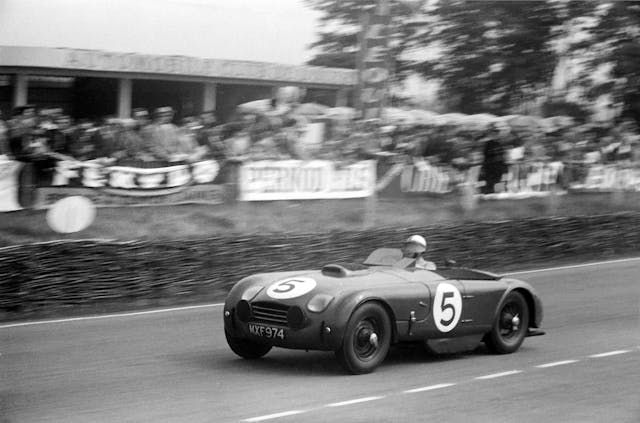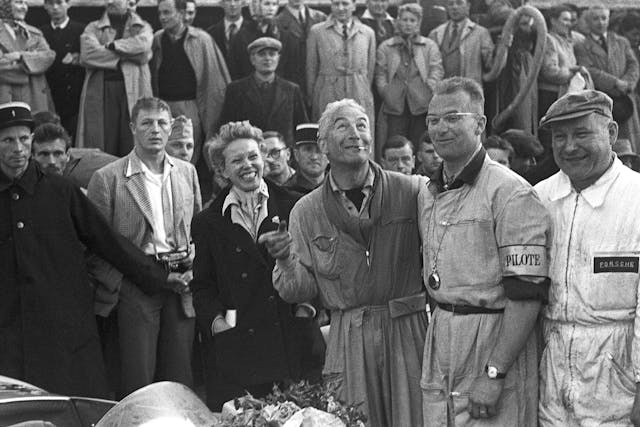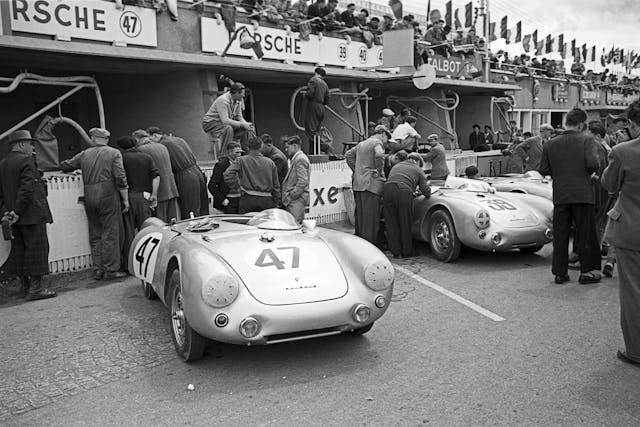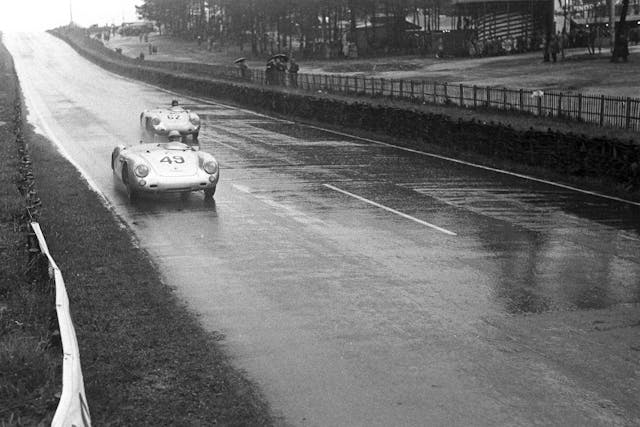Media | Articles
When Porsche almost stole “Mr. Corvette” from GM
If you’re a Corvette aficionado, you know that Zora Arkus-Duntov’s birthday falls on Christmas Day. This April, the month in which he passed away, we’re revisiting a lesser-known chapter of Duntov’s story. This piece originally ran on our site in June of 2017. —Ed.
When you hear the sound of a raspy flat-six in a Porsche 911, it’s likely you don’t think of Zora Arkus-Duntov. After all, he’s Mr. Corvette. Most credit Duntov for saving the Corvette after GM nearly killed it due to poor sales after the Ford Thunderbird debuted in 1955. He also took many risks to establish the Corvette’s racing pedigree during a time when GM was officially not involved in motorsports.
But things may have been different if one of the Corvette’s rivals had its way. Duntov had a golden opportunity to join Porsche in the mid-1950s after distinguishing himself with two class wins at Le Mans while driving for Porsche. He also solved an engineering issue on the Porsche 356 and had carte blanche to join the legendary German automaker.
Duntov, of course, would have been more than happy to race for his own employer at Le Mans or anywhere else, but no such driving opportunities existed at GM in the early 1950s. The corporation was still riding the crest of a postwar demand for cars and trucks, and racing was not part of its immediate business plan.
But Chevrolet chief engineer Ed Cole foresaw the need for Chevrolet and GM to generate excitement among younger buyers as well as to make its products better through the disciplines of racing. This fact would at least open the door for Duntov himself to race, even if Chevrolet wasn’t.
Marketplace
Buy and sell classics with confidence
What led to the Porsche connection? Duntov had established some visibility as a driver in Europe, having competed at Le Mans for Sydney Allard and his British sports car enterprise back in 1953 and ’54. Duntov had worked for Allard in London for several years in the late 1940s, and that connection resulted in the offer of a seat. (Duntov DNF’d both years with mechanical problems.)

While Duntov’s attempts to drive for Allard were met with criticism and almost amounted to his outright dismissal from GM, Porsche had been impressed by his Allard drives. It extended to Duntov an offer to drive the silver cars from Stuttgart in 1955. The Porsche opportunity was more warmly received by GM management based on better timing, if nothing else. Cole felt that GM could learn a lot from Porsche when it came to air-cooled engines and rear swing-axles, as the company was experimenting with rear-engine, air-cooled cars long before the Corvair surfaced in 1960.
Porsche’s 1954 effort was to feature four 550 Spyders. The 550 was a simple yet elegant mid-engine machine that was to become best known as the car that James Dean drove to his death on a California highway in 1955.
Duntov and his codriver, Olivier Gendebien, were set to compete in one of the 550s. Duntov’s car was powered by a 1.1-liter flat four with twin spark plugs per cylinder, while the other team cars had 1.5-liter engines of the same configuration.
When one of the Porsche teams dropped out after only four laps, racing director Huschke von Hanstein decided to run the other three as conservatively as possible. However, after only an hour and a half, the Duntov/Gendebien 550 had lapped the remaining 1.1-liter cars at least once. Driving in a steady rhythm around the 8.3-mile circuit, Duntov learned that there were advantages to having less power. He was able to adopt a much smoother driving style compared what he had previously used in the Allard cars, with their torquey Cadillac and Chrysler engines. Later, some mechanical glitches and a huge rainstorm caused some unforeseen challenges, but Duntov managed to handily win his class.

During the race, Duntov noticed that the handling of his car deteriorated as the amount of fuel in its tank decreased. The fuel tank was located over the front wheels, so with a full tank the front-to-rear weight distribution was 49/51. When empty, it was 45/55. Thinking he knew how to compensate for this phenomenon, Duntov told Ferry Porsche that he’d like to discuss the issue during his prearranged visit to the Porsche engineering facility at Zuffenhausen. Zora had an idea about a front stabilizer bar to help cure the oversteering problem.
Upon arrival, he began working with engineers Helmuth Bott and Leopold Schmidt. Porsche didn’t have a skid pad at the time, but Chevrolet, thanks to R&D head Maurice Olley, was already employing this technique. At Zuffenhausen, Duntov suggested they find an area wide enough to create a skid pad, and such a surface was found at nearby Molsheim airport. There, Duntov showed Bott a dozen tests that GM used to evaluate handling. Bott was impressed with the controlled conditions and measurability of Duntov’s methodology, and he tried different toe-in and rear-wheel camber settings as well as an antiroll torsion bar connecting the front wheels, an addition which also helped reduce oversteer.
Bott and Duntov stayed in close contact after Duntov returned to Detroit, and Duntov sent Porsche many sketches of his stabilizer bar design. After several months of development, Bott tested Duntov’s stabilizer bar design on a Porsche 356 road car, and the car showed marked improvement. Dr. Porsche then asked Bott to begin the same work with the new race car, and Duntov claimed he knocked 30 seconds off its lap time at the 14-mile Nürburgring track. “Like day and night,” Duntov said. “And 1955 Porsche, all Porsche, has a front stabilizer.”

While Porsche did not publicly advertise that a Chevrolet engineer had helped them solve a major problem, the German automaker privately gave Duntov credit, along with an unofficial job offer. Porsche even offered him a new 356 as a goodwill gesture. But Duntov politely declined. He already had what he really wanted—the visibility and respect of the entire Porsche organization.
There were other times when Duntov might have been persuaded to join Porsche had the right position been offered. “There was a time that he wanted to become chief technician for Porsche,” said Anatole Lapine, a friend and design staff contemporary of Duntov’s at GM who later went on to become design director at Porsche. “Ferry would have loved to have the guy on his team—lots of exchange.”
Even though Duntov elected to stay at GM, he corresponded with Bott, von Hanstein, and Ferry Porsche himself for many years afterward, becoming particularly close with von Hanstein. Duntov clearly thought that a bigger opportunity existed at General Motors, which rapidly became the largest corporation on the planet.

***
Epilogue: Duntov was invited back to drive the 1.1-liter 550 Spyder at Le Mans in 1955. He won his class again, but the event was marred by the greatest disaster in motorsport history when the Mercedes of Pierre Levegh came in contact with Lance Macklin’s Austin-Healey and veered into the stands, killing 80 people. Duntov and codriver August Veuillet went on to claim a bittersweet victory, but from that moment forward, all of Duntov’s driving exploits were behind the wheel of a Chevrolet.
***
Jerry Burton is the author of Zora Arkus-Duntov: The Legend Behind Corvette, Bentley Publishers, Cambridge, Mass., 2002.
***
Check out the Hagerty Media homepage so you don’t miss a single story, or better yet, bookmark it. To get our best stories delivered right to your inbox, subscribe to our newsletters.
20170726012512)






Does anyone have any idea which Spyders are in these photographs? Would love to get some insight into the Spyders that are pictured here.
This is the kind of stuff I, as a car nut, love. I had no idea Duntov raced the 550! That is so cool. And his connection to two of my all time favorite cars Porsche and Corvette just makes it that much cooler.
Agreed! Wish we could figure out which 550 chassis numbers he raced!!
Despite Duntov’s success at Le Mans, three-time Indy 500 winner, Mauri Rose, who worked at GM with Duntov as an engineer, led the team that fabricated the first Corvette prototype, and installed the V8 engine in the “Duntov Mule” (the first Corvette with a SBC) pictured at the top of the story, said that Duntov “couldn’t drive a nail.”
https://www.hagerty.com/media/people/mauri-rose-unsung-hero-of-corvette-racing-legacy/
great article !